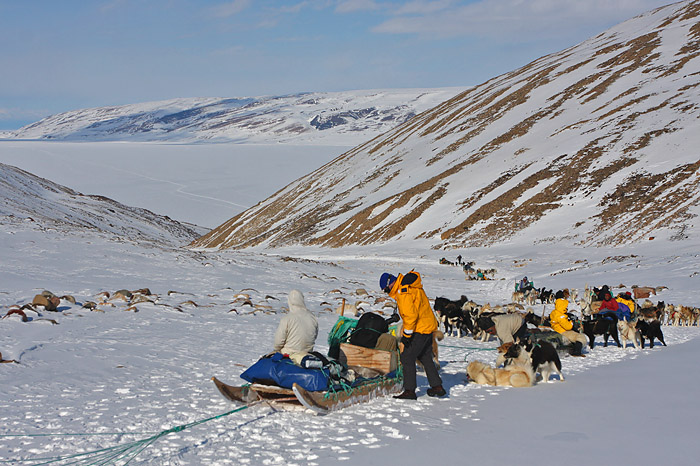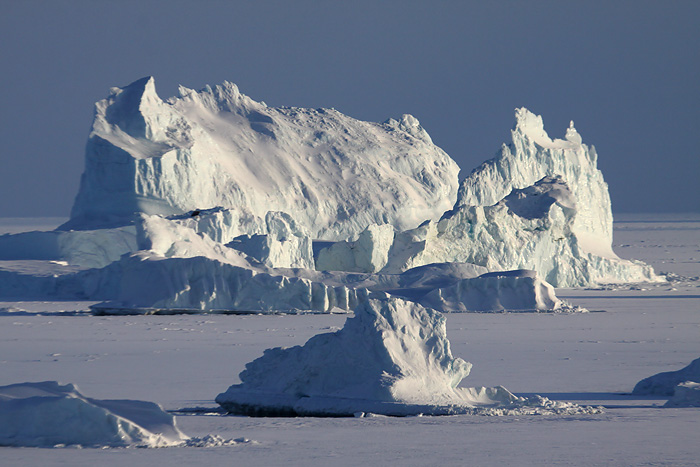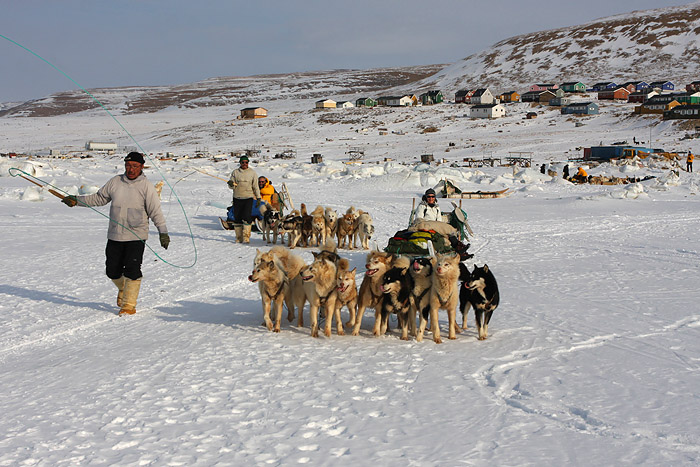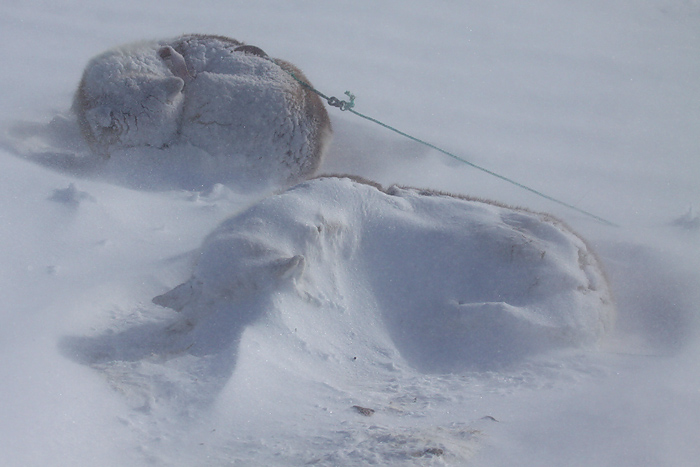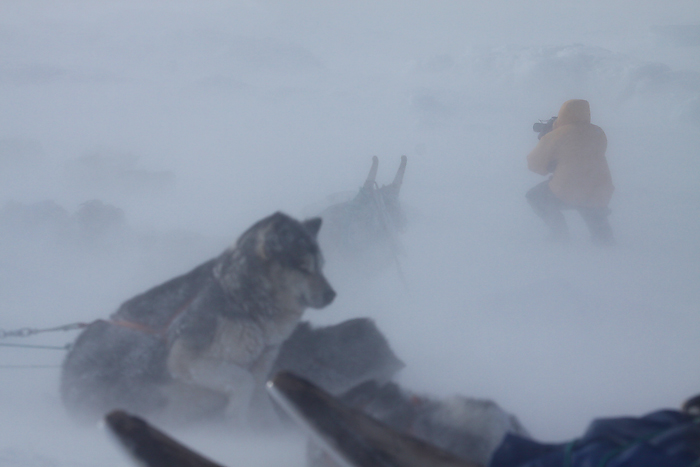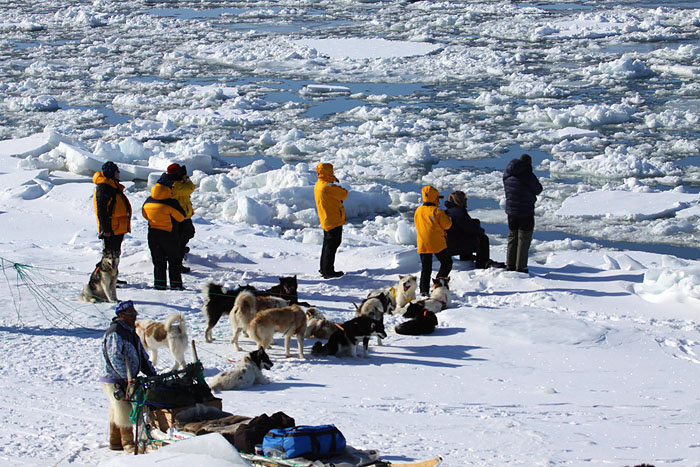GREENLAND TRADITIONAL DOGSLED EXPEDITION
Greenland - The unexplored world of the North
THIS TRIP WAS FEATURED IN THE 2010 WINTER ISSUE OF CAPA
GREENLAND TRADITIONAL DOGSLED EXPEDITION
Beautiful ice, dogs, inuits, icebergs, seals and igloos
2024-04-17 - 2024-04-26
The climate changes in the Arctic, the hunting of endangered species and the fast-evolving Inuit lifestyle are controversial topics of nearly every environmental conversation in the world, though very few have first-hand experience in this region. By participating in a one week traditional dog sled 'hunting' expedition, we will not only become credible Polar explorers, but through a life-changing experience, we will learn an amazing array of insightful details of the North - from ice conditions to traditional hunting methods, to languages, to possible eye-to-eye encounters with endangered species, to survival skills, to igloo building methods, to the tastes of unusual foods, to harpoon-throwing contest, and not the least, the fascinating way current day technologies mingle with tradition and culture in daily Inuit life.
This expedition is exceptional, because it serves to promote one of Hivekovics Expeditions's sustainable tourism goals. The Inuit people have led a very subsistence lifestyle for generations, which unfortunately is collapsing as western views, religious organizations, and international communities and organizations place pressure on them to change their ways and modernize. Particularly, there is major international controversy over whether hunting by native peoples is negatively affect existing populations of endangered and threatened species, such as the Narwhal and Polar Bear. This trip allows its participants to understand the challenges native peoples face to survive in remote, isolated, and "unproductive" regions, while at the same time helping to establish a new means of survival and economy through tourism fees, without disrupting their traditional and evolving lifestyles.
This trip was difficult to plan, but in the end, we were able to convince our hosts that while we wanted as an authentic experience as possible, and the opportunity to get as close to the animals as space and safety would allow, that except for unavoidable and necessary circumstances, when it came down to firing the final "shot", the only clicking to be heard would come from our cameras and blanks being fired from their guns as they demonstrated how they would carry out the kill. This expedition is a pioneer step for transitioning natural and cultural resources from predation to protection, while generating understanding in a global world, and preserving traditional values. This trip was featured in the 2010 winter issue of CAPA, and is a true expedition and an incredible dream for a true adventurer! Sign up now!
Detailed itinerary:
Apr 17 Copenhagen/Kangerlussuaq/Ilulissat
Our unique and exciting expedition to the world of ice and native traditions begins in Copenhagen, the capital of Denmark. Greenland is an autonomous territory of the Kingdom of Denmark, and Copenhagen is the most convenient, or we can say, the only international hub for air travel to this giant arctic island. Our meeting time is at 7 in the morning. Once everybody is together, we distribute the food package that is include in the tour price (to be used during the dogsled trip only) and check in for our Air Greenland flight to Ilulissat. We take off from Copenhagen at 9:15 in the morning, and after a 5 hours flight due west, we land in Kangerlussuaq at 9:45 am local time. Here we change to a specialized aircraft that services the Greenlandic communities under cold conditions. Our connection takes off at 11:55 am, so we have a comfortable two hours to get off our big plane, warm up in the waiting lounge in Kangerlussuaq, before boarding our smaller local airplane. We will arrive at Ilulissat 2:50 in the afternoon. At the end of April, there is almost 24 hours daylight here, so we will have plenty of time to get to our accommodation and to discover this interesting township. Ilulissat (aka Jakobshavn from founder Jakob Severin) is the third largest settlement in Greenland after Nuuk and Sisimiut. The town has a population of 4,670. It lies in the municipality of Qaasuitsup, about halfway up the country's west coast, and about 200 km north of the Arctic Circle. In direct translation, Ilulissat is the Greenlandic word for "the icebergs". Ilulissat is Greenland's most popular tourist destination on account of its proximity to the picturesque Ilulissat Icefjord. The Icefjord runs west 40 km from the Greenland ice sheet to Disko Bay close to Ilulissat town. At its eastern end is the Jakobshavn glacier, the most productive glacier in the Northern Hemisphere. The glacier flows at a rate of 20-35 meters per day, resulting in around 20 billion tons of icebergs calved off and passing out of the fjord every year. So while we do not have an organized program for the rest of the day (other than lunch and dinner at the hotel), those who are interested can easily arrange a transfer from our hotel to visit the fjord and the glacier. Otherwise there is plenty of other things to see in town, and it is quite fun to just stroll around and get to know the locals and their lifestyle. We shall all be back at the hotel by 8 pm for a great dinner and some rest before another great day in Greenland.
Accommodation: Hotel Icefjord
Apr 18 Ilulissat/Qaanaaq
Due to an early departure from Ilulissat this morning, we have a long day ahead of us today. Plan to be at the breakfast table no later than 6 a.m. in order to depart for the airport by 6:30 am. At 08:25 we depart and head due north. We land for a short break in Upernavik, but take off again at 10:20 to land in Qaanaaq at 12:10. From the airport we will be transferred to our accommodation in Qaanaaq. These are two private houses that recently have been modified for tourism purposes. Although these houses are not luxurious, they offer all the modern amenities and comforts we will need, including: simple beds with comfortable mattresses, heat, kitchen, bathrooms with hot showers, and storage space. Once we have taken our rooms, we will take off to explore the town or to purchase some additional items from the local (well-supplied) store. At some point in the afternoon, we will meet the representative of our local hunters, who will carry out a short demonstration of the sleds, the sleeping arrangements and other items to be used on the ice. We will put all the hunters' name into a hat and we each pull a name. As we get to know the representative, and listen to his update about weather predictions and latest news on wildlife movement in the area, we will lay out the anticipated schedule for the following days. This orientation will be our first and best opportunity to begin to learn and understand their daily life, society, culture, and the survival skills necessary in such an environment. This is also a great opportunity for you to express world values concerning preserving biodiversity. An interpreter will help us communicate and to ask any questions we may have - a luxury that will not be present later during the trip. Once on the ice, communication will be a challenging, yet exciting and rewarding part of our experience. Still, it is important to express our interest and curosity, and to encourage them to naturally go about their activities, while we document their daily lives in a typical environment. We appreciate if the hunters bring their weapons and demonstrate how they would approach and kill the animals (including seals, birds, and the very occasional Polar Bears and Narwhals) in the field. After the representative leaves, your expedition leader will check our modern equipment, making sure we are all adequately prepared for life on the ice. Your leader will also set a departure time and an approximate route for the next 6 days. Once this is all settled, we will have a few more hours of free time in the village and a self-organized dinner, before going to bed to rest one last time in a heated room with a proper mattress.
Accommodation: Bunk House
Apr 19 Qaanaaq/Dogsled Expedition
Breakfast will be around 7 am as that we are expecting our hunters to come and meet us at around 9 am. Again, the exact trip schedule, timing and routing will be re-evaluated with them upon arrival, because it entirely depends on the weather and the ice conditions. Soon following their arrival we will depart on our amazing expedition on dogsleds covered with our gear and the local equipment. Our hunters will bring a very basic canvas tent and some warm fur blankets to cover the sled, so other than our warm Arctic expedition wear, we only have to carry our own sleeping bag, an air mattress, and our own food. Once we reach our camp of the day, two hunters will put their emptied sleds together and will erect a tent over the sleds. This way the sleds become a large bed, catering for 4 people: two of us and two local hunters. The hunters will have a small stove for heating and some cooking equipment, so we will have a moderately supplied life inside. Occasionally, there will be abandoned hunter's huts near to our camp, so all or some of us will be able to spend the night in those. But this is still the future; we are, at the moment, just taking off for our first day of exploration over the sea ice. Most probably, at first we are heading North East, towards a more northerly settlement, called Siorapaluk. We shall reach the settlement in about 6-8 hours and stop for a few hours. We can stroll around, explore the local lifestyle and the huge Little Auk colony on the cliffs behind the settlement, while our hunters will discuss the latest wildlife movement news with their local colleagues in order to determine a more precise route for the rest of the week. Late in the afternoon, we will take off in the desired direction again, and will set up our camp for the night after a few more hours of sledding. Depending on the actual conditions, we might already reach the edge of the ice and the large polynia that is usually at this part of the North Baffin Bay. Either way, we shall set up our camp for tonight, blow up our air mattresses and each cook our own dinner, using the equipment of your host, or if you like, your own. Since by the end of April the sun never goes down, we will have to adjust to nights that are quite bright throughout.
Accommodation: dogsled camp
Apr 20 Dogsled Expedition
Our first morning on the ice! After a gentle wake up call by our hunters at around 8 am, we prepare our breakfasts, take the camp down and venture off in search of wildlife, ice and other interesting things to see. Depending on the actual conditions, we might follow the edge of the sea ice for quite a while, looking for any signs of Narwhals or seals, or we might go inland, following the footsteps of a Polar Bear or any other wildlife signs such as the Arctic Fox or Arctic Hare. We will spend a full day on the ice, learning as much as we can about the techniques of Inuit dog sledding, wildlife tracking and other survival skills. At one point, we will also learn the easiest and best way to erect a proper ice igloo. By the end of the day, late in the afternoon or early in the evening, we set up our camp again and have yet another fun night, trying to cook our own meals.
Accommodation: dogsled camp
Apr 21 Dogsled Expedition
Another full day out on the ice with our dogs and hunter hosts. The exact activity of the day will be determined by them and by the weather, animals and ice conditions. We will organize a harpoon-throwing contest and build a proper igloo-wall around our portable toilet (practicing our new igloo-building skills).
Accommodation: dogsled camp
Apr 22 Dogsled Expedition
Another full day out on the ice with our dogs and hunter hosts. The exact activity of the day will be determined by them and by the weather, animals and ice conditions.
Accommodation: dogsled camp
Apr 23 Dogsled Expedition
Another full day out on the ice with our dogs and hunter hosts. The exact activity of the day will be determined by them and by the weather, animals and ice conditions.
Accommodation: dogsled camp
Apr 24 Dogsled Expedition/Qaanaaq
Today we will still spend a whole day out on the ice, but during the last day or two, our hunters have been designing our routes the way that today we will be in no more than 8 hours dogsled-distance from Qaanaaq. So after a possibly very long day, running across the frozen sea or land with our dogs and sled, we shall return to Qaanaaq, the first real sign of civilization after an entire week out on the ice. We take our 'usual' rooms in the two private houses, cook our own meals and after a well-deserved hot shower, enjoy re-packing our belongings for our departure the following day and will have an hour session with the hunters' representative and an interpreter again, allowing us to ask any questions we may have left. A great night sleep on a proper mattress!
Accommodation: Bunk House
Apr 25 Qaanaaq/Ilulissat
Our flight back to Ilulissat doesn't depart until 1 pm, so we have a comfortable morning to deal with all what we wanted to. We can either stroll around town one more time and take some pictures, visit the local souvenir shop for the perfect momento, visit our hunters in their homes and say a proper goodbye to them and to the dogs, or you can simply sleep in after our tiring last week and finish packing this morning. Plan on departing by 11am to check-in for our flight to Ilulissat. At this time our airplane is likely to stop not only in Upernavik, but also in Quaarsut, but we will still get to Ilulissat as early as 5 in the afternoon. Which, again, due to the constant daylight, gives us enough time to do further explorations in the region. There are no organized excursions, but you are welcome to explore the town or enjoy the brewery within our Hotel. Dinner will be an organized event to properly send us off after such a pioneering expedition. With so much fun and such a rich experience behind us, we will certainly have a lot to discuss and recap on. After dinner, we will retire to save some last bits of energy for yet another long flight back to Copenhagen.
Accommodation: Hotel Icefjord
Apr 26 Ilulissat/Copenhagen
Our flight leaves as early as 07:20 in the morning, so we will have a very early breakfast, followed by a transfer to the airport. Just like on the way up, we change aircraft in Kangerlussuaq and depart on our final flight at 11:25 am. It is going to be as late as 19:45 upon our landing in Copenhagen, but there are still plenty of later flights out of the city to most European or North American destinations, so our exciting expeditions ends here at Copenhagen Airport, with all of us spreading out in transit and catching our connecting flights. Have a safe trip home!
Price includes:
- all accomodation
- all meals
- all activities mentioned in the program
- all land transportation
- all airport and local transfers
- all national park fees
- all camping gear except sleeping bag
- all local guiding fees
- international tour leader
- all government taxes and levies
- one hunter with one team of dogs per person
Price excludes:
- international flights
- travel insurance
- personal expenses at accommodation
- departure taxes at airports
- visa fees
- any other items not mentioned above
- all domestic flights

